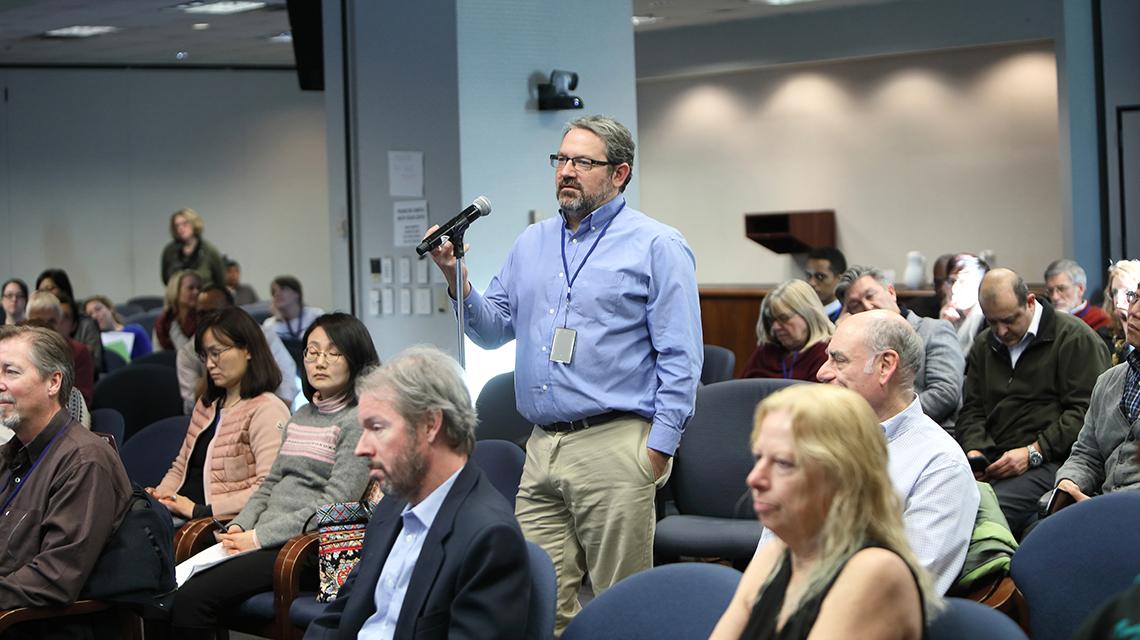Smartphone Dashboards
Big Data May Help Patients Manage Their Health

Photo: Chia-Chi Charlie Chang
Wearable biosensors may soon be able to detect when a person is getting sick before he or she realizes it, said Dr. Michael Snyder at a recent NIMH Director’s Innovation Speaker Series lecture at the Neuroscience Center.
“Big data will have value. Now, it’s a question of which data forms will have more value,” said Snyder, Stanford W. Ascherman professor and chair, department of genetics and director, Center for Genomics and Personalized Medicine at Stanford University.
To answer that question, Snyder began enrolling patients 8 years ago in a longitudinal study at Stanford to characterize an individual’s healthy state and observe what happens when he or she gets sick.
All enrolled patients have their genomes sequenced and give blood samples so Snyder can build a “personal omics profile.” This includes information on how a genome is expressed, microbes found on the skin and in the stomach, a person’s metabolic profile and even substances a person is exposed to in the environment.
When participants are healthy, his lab takes samples from them every 2 or 3 months. The lab also takes samples whenever someone gets sick.
“We’re making billions of measurements every time we sample folks,” he noted.
Snyder was the first to enroll in the study. Since then, he’s been through 11 viral infections, a Lyme disease diagnosis and a bike accident. “I don’t look for these things, but when they happen I might as well get good data,” he said.

Photo: Chia-Chi Charlie Chang
Sequencing his DNA was valuable. His genome suggests he’s at increased risk for high cholesterol, a type of skin cancer called basal cell carcinoma and type 2 diabetes. Of the patients enrolled in the study, “17 percent of people had clinically actionable information in their genome,” he said. This includes individuals who are at high risk for cancer, one person who was misdiagnosed with type 2 diabetes (but was really a different form of diabetes called MODY) and another person who was at high risk for a heart defect and was later found to have that defect.
Besides genome sequencing, other types of data were also valuable. For example, some were pre-diabetic and had no idea they had the condition. Another patient had a serious heart condition. And one patient had undiagnosed lymphoma. Because it was caught early, it was treatable.
A few years ago, Snyder incorporated data from wearable sensors into the study. He can now measure heart rate, skin temperature, blood oxygen levels and activity and sleep patterns. He wears eight of them daily.
“Nearly all of these wearables will transfer information back into your iPhone,” he explained.
Because of a wearable, he discovered that blood oxygen levels decrease on flights. He believes the drop in blood oxygen causes fatigue. Usually, the levels will go back to normal on long flights.
On one flight to Norway, he saw his oxygen level decrease more than normal. It stayed low until he got off the plane. He later learned that his heart rate and skin temperature increased. He warned a doctor in Norway that he might have Lyme disease because he remembered helping his brother put up a fence in rural Massachusetts a few weeks earlier.

Photo: Chia-Chi Charlie Chang
The doctor prescribed doxycycline, an antibiotic used to treat early Lyme disease. Later tests confirmed he had the disease.
“The first I detected the disease was with my wearables,” he said.
He believes a person’s heart rate will predict when someone is starting to get sick. His team is writing an algorithm that will alert people when they should see a doctor if their heart rate goes up higher than expected based on their activity. He hopes that smartphones will become personal health dashboards that interpret data for patients.
“This information can be shared with your physician so that your physician can get better measurements,” Snyder concluded. “That’s very powerful.”
